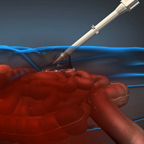A New Darpa Advance Mass Might Offer Hope for Shipboard Injuries
A DARPA announcement today touted the initial results of the Wounded Statis Sytem. The pre-clinical tests showed injecting a polyurethane polymer foam into the chest cavity of an injured servicemember suffering from internal hemorrhaging could increase stoppage of blood loss 6-fold, and boost chances of survival at three hours post-injury from ~8% to 72%. Removing the foam in a singular solid chunk reportedly takes less than one minute after making a small incision.
While the press release is geared toward ground-combat survival, medical departments in the U.S. fleet would surely be just as interested in having a few of these injections on hand in the event of a singular of mass casualty incident requiring a medical evac for just this reason:
The Department of Defense’s medical system aspires to a standard known as the “Golden Hour” that dictates that troops wounded on the battlefield are moved to advanced-level treatment facilities within the first 60 minutes of being wounded. In advance of transport, initial battlefield medical care administered by first responders is often critical to injured servicemembers’ survival. In the case of internal abdominal injuries and resulting internal hemorrhaging, however, there is currently little that can be done to stanch bleeding before the patients reach necessary treatment facilities; internal wounds cannot be compressed the same way external wounds can, and tourniquets or hemostatic dressings are unsuitable because of the need to visualize the injury. The resulting blood loss often leads to death from what would otherwise be potentially survivable wounds.
DARPA launched its Wound Stasis System program in 2010 in the hopes of finding a technological solution that could mitigate damage from internal hemorrhaging. The program sought to identify a biological mechanism that could discriminate between wounded and healthy tissue, and bind to the wounded tissue. As the program evolved, an even better solution emerged: Wound Stasis performer Arsenal Medical, Inc. developed a foam-based product that can control hemorrhaging in a patient’s intact abdominal cavity for at least one hour, based on swine injury model data. The foam is designed to be administered on the battlefield by a combat medic, and is easily removable by doctors during surgical intervention at an appropriate facility, as demonstrated in testing.
Up next is clinical testing, and before long, someone you know may have an interesting memento bearing the faint impression of their internal organs.

